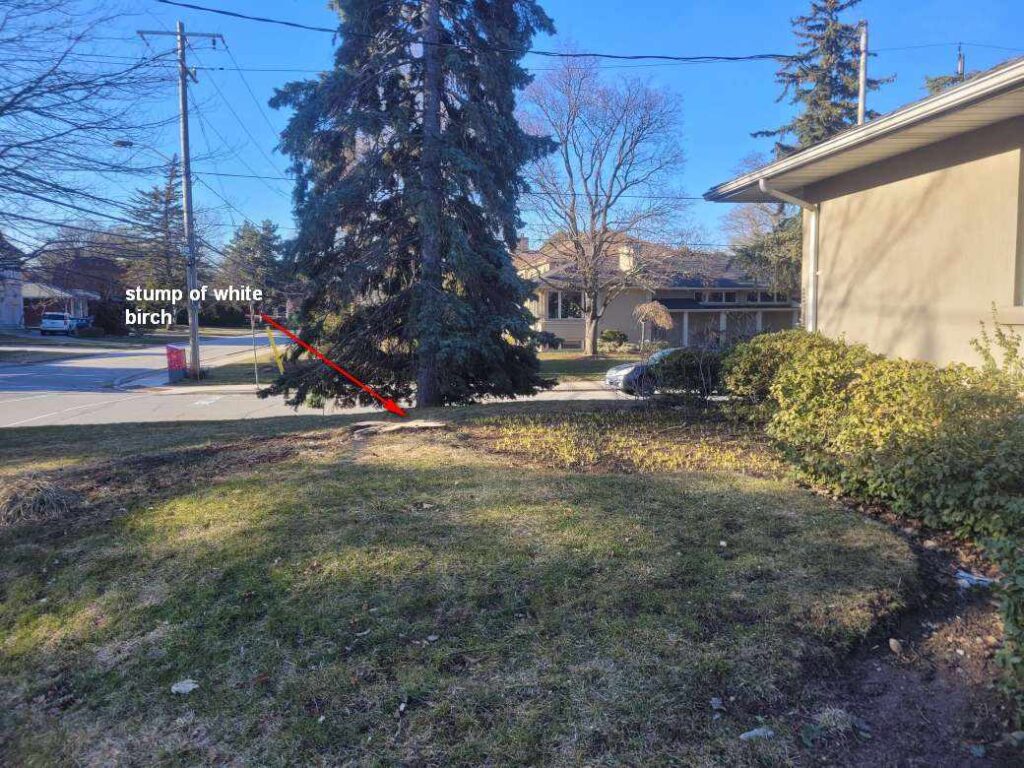
The white birch in front of my house died year and a half ago.
We received permission to remove it and per the tree bylaw has to replant another tree. The arborist suggested a tulip tree for the report and we can change it later. My concern is a) the birch is about ten feet from the house and the tulip tree is too big (mature height 59ft & 20 ft width) for that location. b) the Hydro line is quite close by at the corner of the house (please see location plan). I am wondering if planting a Bloodgood Japanese Maple or a Radiant Crabapple is acceptable to the city or do you have a suggestion?
Thank you for contacting Toronto Master Gardeners about suitable replacements for your dead white birch. It is great that you are taking care over placement of the proposed new tree, and also considering other options to the tulip tree your arborist suggested. Let’s talk about this, but I want to encourage you to ask your arborist to address these valid concerns. He or she has been on site and will have noted underground services (hydro and telephone wires), soil condition, sun and wind issues, and will likely have thought about possible damaging effects of city road salt.
It is hard to tell from your photograph, whether the location is on your privately owned property, or on a City of Toronto owned road allowance. I am inclined to think that it is City owned which would be the reason your arborist suggested a Tulip tree, as this is on the list of trees permitted on road allowances. This can be found at https://www.toronto.ca/wp-content/uploads/2021/05/9765-Street-Tree-Brochure.pdf. Most of these trees are large due to the City’s objective to provide long term urban forest cover, but a few are listed as medium sized, so those might be possibilities for you to consider.
If the location is not on City property, then you can decide to plant anything you like (subject to rules relating to overhanging branches etc.) but your arborist will be able to guide you on this. A good source for investigating trees suitable for Toronto private properties, is the website of the non-profit organization LEAF (Local Enhancement and Appreciation of Forests ) https://www.yourleaf.org.
You clearly mention size as a factor in your choice, but there are other factors to consider, such as :
- Curb appeal: bark and leaf colour can harmonize nicely with a home’s colour, enhancing, or softening it;
- Do you know the cause of death of the birch? This may help you decide on a replacement that is less susceptible to that/those condition(s). Birch are short- lived so may have died a natural death, leaving you no lingering concern. But it might be helpful for you to know that some deciduous trees like serviceberry, mountain ash, honey locust and some sugar maples tolerate salt .
As for Tulip trees (Liriodendron tulipifera ): they are native, have lovely lime/emerald green, interesting-shaped leaves that provide good shade and after a few years, fabulous yellow flowers (superficially resembling tulips) in late spring. They grow fast and large (59’ high and 20’ spread), the advantage of which is shade, which is why they are on the City approved list .
Crab Apple trees( Malus spp) are not on the City approved list, but are architectural, ornamental and of modest size. I cannot tell from the photo how close to the sidewalk it would be planted, but perhaps falling apples would be messy near a public walkway. Flowers are wonderful, and pollinator magnets: good for the environment, but less so for people with allergies walking by.
Bloodgood Japanese Maples (Acer palmatum) are considered reliable, and are undeniably beautiful living sculptures of modest height and spread, but not on the City list, so this would be a possibility only if you plant on your private property. If you know you have a road salt issue, consider whether this might be a better choice for closer to your house, or your back yard, where it might also be protected from wind and direct afternoon sun.
Another couple of suggestions if your location is owned by you:
Serviceberry (Amelanchier) is a native tree that matures at about 30 feet or less (mine is 20 years old and still only about 10 feet high), produces lovely white flowers in early spring, edible red berries in July (if you can harvest them before the birds do) and caramel-tinged red leaves in the fall. (Note: Do not plant these if there are junipers nearby, as the two infect each other).
Redbud (Cercis canadensis) is a very pretty native feature tree, and robust, although it spreads branches wide and might shade out grass or underplanting.
Honey locust (Gleditsia triacanthos) grows to about 35 feet, has an open spreading crown, yellow/orange fall leaves, likes sun, which you have, tolerates road salt, has small leaves that filter light (so does not shade out underplanting and grass), but seed pods need to be raked (there are cultivars that do not produce seed pods).
Hope some of this helps . Good luck with your tree choices!

